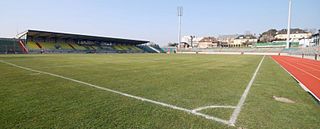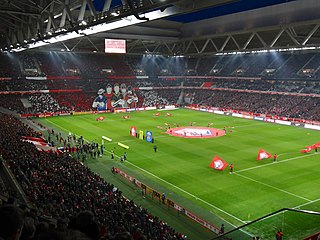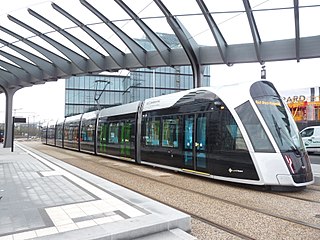
Transport in Luxembourg is ensured principally by road, rail and air. There are also services along the river Moselle which forms the border with Germany. The road network has been significantly modernised in recent years with motorways to adjacent countries. The advent of the high-speed TGV link to Paris has led to renovation of the capital's main railway station while a new passenger terminal at Luxembourg Airport has recently been opened. Trams in the capital were reintroduced in December 2017 and there are plans for light-rail and/or tram-train lines in adjacent areas.

Luxembourg, also known as Luxembourg City, is the capital city of Luxembourg and the country's most populous commune. Standing at the confluence of the Alzette and Pétrusse rivers in southern Luxembourg, the city lies at the heart of Western Europe, situated 213 km (132 mi) by road from Brussels, 372 km (231 mi) from Paris, and 209 km (130 mi) from Cologne. The city contains Luxembourg Castle, established by the Franks in the Early Middle Ages, around which a settlement developed.

Luxembourg Airport is the main airport in Luxembourg. Previously called Luxembourg Findel Airport due to its location at Findel, it is Luxembourg's only international airport and is the only airport in the country with a paved runway. It is located 3.25 NM east of Luxembourg City. In 2019, it handled 4.4 million passengers. It is a major cargo airport, ranking as Europe's fifth-busiest by cargo tonnage and the world's 28th-busiest in 2010. Luxair, Luxembourg's international airline, and cargo airline Cargolux have their head offices on the airport property.

The Luxembourg national football team is the national football team of Luxembourg, and is controlled by the Luxembourg Football Federation. The team plays most of its home matches at the Stade de Luxembourg in Luxembourg City.

The Stade Josy Barthel is the former national stadium of Luxembourg, and the former home of the Luxembourg national football team. The stadium, which also hosted rugby union and athletics events, is located on route d'Arlon, in the Luxembourg City quarter of Belair. Following the opening of the Stade de Luxembourg in September 2021, the stadium and its grounds are currently due for demolition and redevelopment.

The Stade de France is the national stadium of France, located just north of Paris in the commune of Saint-Denis. Its seating capacity of 80,698 makes it the largest stadium in France. The stadium is used by the French national football and rugby union teams for international competitions. It is the largest in Europe for track and field events, seating 78,338 in that configuration. During other events, the stadium's running track is mostly hidden under the football pitch.
Same-sex marriage has been legal in Luxembourg since 1 January 2015. A bill for the legalisation of same-sex marriages was enacted by the Chamber of Deputies on 18 June 2014 and signed into law by Grand Duke Henri on 4 July. Partnerships have also been available in Luxembourg since November 2004.

Belair (formerly:"Neumerl") is a quarter in western Luxembourg City, in southern Luxembourg.

Lesbian, gay, bisexual and transgender (LGBT) people in Luxembourg have the same legal rights as non-LGBT people. Partnerships, which grant many of the benefits of marriage, have been recognised since 2004. In June 2014, the Luxembourgish Parliament passed a law enabling same-sex marriage and adoption rights, which took effect on 1 January 2015. Additionally, discrimination on the basis of sexual orientation and "change of sex" in employment, healthcare and the provision of goods and services is outlawed, and transgender people are allowed to change their legal gender on the basis of self-determination.

Miloud Hadefi Stadium, is a multi-use stadium in Belgaïd, in the Bir El Djir suburb of Oran, Algeria. Completed in 2019, it is used mostly for football matches. It has a capacity of 40,143 people. The value of construction work of the stadium was about 142,3 million US$, it is an olympic stadium with the athletics track and it is a part of the Miloud Hadefi Olympic Complex which is the first big complex in Algeria exceeding the Mohamed Boudiaf Olympic Complex in Algiers and it is also the first stadium entirely covered in Algeria. The stadium expected to be special for the Algeria national football team with Stade du 5 Juillet and Nelson Mandela Stadium, and also clubs of Oran especially MC Oran.

The Stade Pierre-Mauroy, also known as the Decathlon Arena – Stade Pierre-Mauroy for sponsorship reasons, is a multi-use retractable roof stadium in Villeneuve-d'Ascq, France, that opened in August 2012. It has a seating capacity of 50,186 and is the home stadium of Lille OSC. Initially named Grand Stade Lille Métropole, the stadium was renamed on 21 June 2013, just after the death of the former Mayor of Lille and former Prime Minister of France Pierre Mauroy (1928–2013).

The first generation of trams in Luxembourg ran from 1875 to 1964, before being withdrawn from service and the tramways removed. A second generation of trams began operational service on 10 December 2017, along a new route that will, by the end of 2024, run from Luxembourg Airport to the Cloche d'Or business district, in Gasperich, serving the new national stadium, via Pfaffenthal-Kirchberg and Luxembourg railway stations. Additional lines are planned for the network both within Luxembourg City, as well as extending to Strassen and Esch-sur-Alzette.
Stade TP Mazembe is a multi-use stadium located in the Kamalondo suburb of Lubumbashi, Democratic Republic of the Congo. Since its completion in 2012, it has mostly been used for football matches and is the home venue of TP Mazembe and CS Don Bosco. The stadium has 18,000 seats.

The Matmut Atlantique, also known as the Nouveau Stade de Bordeaux, is a football stadium in Bordeaux, France. It is the home of Ligue 2 club FC Girondins de Bordeaux and seats 42,115 spectators.
The Stade Municipal de la Ville de Differdange or simply Stade Municipal is a stadium in the town of Differdange, Luxembourg. It is one of the home grounds of FC Differdange 03, along with Stade du Thillenberg, and holds 3,500 people.

Alassane Ouattara Stadium, commonly known as the Olympic Stadium of Ebimpé and formerly as the National Stadium of the Ivory Coast, is a multi-purpose stadium in Ebimpé and Anyama, in northern Abidjan. It opened in 2020. The stadium hosts major football matches including home matches of the Ivory Coast national football team. Alassane Ouattara Stadium is owned by the Government of Ivory Coast. With 60,000 seats, it is the largest stadium in Ivory Coast and one of the most modern stadiums in Africa.

The Diamniadio Olympic Stadium, also known as the Stade Me. Abdoulaye Wade is a multi-purpose stadium, which can host football, rugby and athletics, in Diamniadio, in Dakar, Senegal. It is the national stadium of the Senegal national football team. The stadium which has a capacity of 50,000 designed by Tabanlıoğlu Architects and built by Summa. It will host the 2026 Summer Youth Olympics.
The Euroforum building is an office complex used by the European Commission in Cloche d'Or, Gasperich, Luxembourg City, Luxembourg. It hosts, amongst other European Commission departments, the Euratom Supply Agency.
Fabio Lohei is a Luxembourgian footballer who plays as a left-back for the French club Metz II and the Luxembourg national team.
















